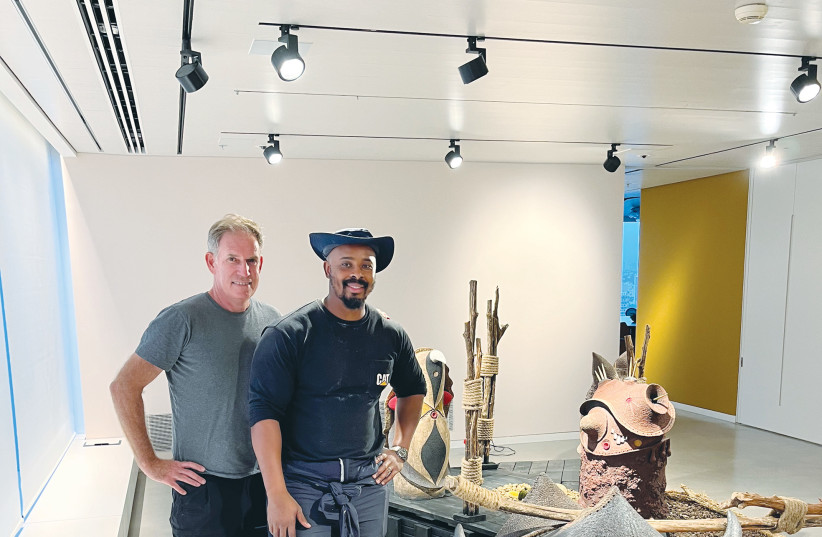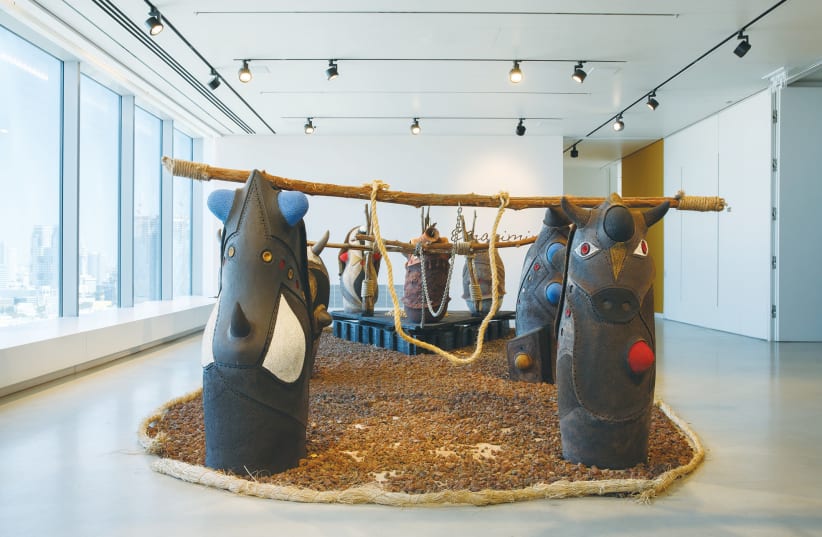“I try to embrace the raw culture, the old culture, my roots, where I understand more about myself,” says artist Simphiwe Mbunyuza about his new installation, Emasimini (In the Fields), presented recently at the African Studies Gallery in Tel Aviv.
Invited to Israel as part of the Africa First residency program, founded by Serge Tiroche, Mbunyuza spent three months here, splitting his time between the ceramics department of the Bezalel Academy of Arts and Design in Jerusalem and the Shenkar College of Engineering, Design and Art in Ramat Gan.
Mbunyuza (born in 1989 in Butterworth, Eastern Cape, South Africa) creates masterful clay sculptures combining stoneware, wood, textiles and steel. His richly textured ceramic objects are inspired by Xhosa culture, featuring traditional iconography and cultural symbols of his ancestors.
He has been the subject of numerous exhibitions around the world, including recent presentations with Marianne Boesky in Aspen, Colorado, at Gallery 1957 in London, and in Accra, Ghana. He is the recipient of awards and residencies, including the Anderson Ranch Arts Center in 2021; the Red Clay Faction Award and Oscar Jacobson Award from the University of Oklahoma in 2019; a residency with A.I.R. Vallauris, France, in 2017, and has been invited to participate in a two-year residency at the world-renowned Archie Bray Foundation in Montana.
“This installation was inspired by my family on my mother’s side. They come from a village, and that is where I learned about my ancestors and our culture. My father’s side were more westernized. If they needed to plow a field, they would hire a tractor. But from my mother’s side they used the traditional way.


“I loved going to my grandfather in the village. He had cows, goats and sheep, but I didn’t like to work with the cows, because I was afraid of them,” he says with a smile. “You have to hold the rope, and the large bull in front is strong and it chases people. You can see in the work the one that is frightening,” he says, pointing to one of the pieces. “I try to embrace my culture – to show these experiences in my work,” he says and explains that this is his way of preserving his heritage. “Soon this way of life will disappear. It will not even be in books or museums. I want to remember it, to celebrate it in my art.”
“Soon this way of life will disappear. It will not even be in books or museums. I want to remember it, to celebrate it in my art.”
Simphiwe Mbunyuza
We go around the installation. From close you notice the details, the rich textures and shapes, as well as the symbols. You see the landscape divided by barbed wire, to keep the cows from running away; the texture of the earth; the colors of the houses; the women and the animals. Looking at the installation, you can almost see the bulls pulling the plow, and the dust rising around them.
I ask him about an icon I see in all of the works, five white stripes in different lengths.
“I took it from Mbira [African harp], and it represents music. Music is the real inspiration of Africa,” says Mbunyuza. “We are people of music. The songs are more like prayers in a way. Singing gives you power and courage in war and also in the fields. The music gives you energy and the ability to go on when it is difficult. Someone starts to sing and everyone joins in.
“The sculptures I have produced contain the elements of these cultural practices,” says Mbunyuza, pointing at the textures, some of which represent the fields, others which represent the women, the rivers and the sea, the angels and the deep connection to the ancestors.
But it is not all about everyday practices. Some symbols pay homage to the sad history of Africa. “Some symbols also represent the wars, the invaders who came with guns. We plow the fields, they came to take from Africa the land and the gold.”
Mbunyuza explains that in his culture, the connection to your ancestors is very important. “There are many places where you go to speak to your ancestors – some are in the river, some in the mountains or the sea, so I find a way to embrace these elements in the work.
“The body of the sculptures is created in a way that represents our women ancestors and their abilities, considered just as important as the men’s abilities in my Minotaur-themed pieces.”
The artist says that part of his work is to honor his ancestors’ genius.
“You see in the work the wood – how they carved it, even in the structures of the mud houses. There is music in the design and the decorations, how they painted the houses. They had to make their own colors, using red and white clay from the river banks.”
Mbunyuza started creating clay cows as a child. “We grew up in the fields, looking after the cows. We used to go to the river banks and use the clay we found to make small cow statues.
“At school I had an English teacher who was an artist. She noticed that during class we were always drawing instead of listening. One time when she came directly to me I dropped my sketches to the floor to hide them, but she saw [them] and she said that we could come to the school on weekends and she would teach us.”
The teacher sent Simphiwe and his friends to art competitions, and later he attended art school. “All I knew was drawings. I didn’t know that working with clay could also be art. But when I saw it at the art school, I was immediately drawn to clay. It reminded me of my childhood, and I easily fell back in love with it, and it became my main interest. I am also a painter, but the clay – that’s me.”
As part of his work, Mbunyuza uses building and coiling techniques that were employed by the Xhosa people for centuries. Building a mud-brick house with his father, he learned about construction and supporting, about plastering and about painting. These skills make him confident he can create large ceramic objects.
When I wonder about the technical problems, he shrugs his shoulders and says that the size of his objects is limited only by the size of the kiln he can use. “I do them in one piece. I am capable of doing them in one piece. This is one of the reasons I like to go on residency in places where they have large kilns. I want to build really large works that can be placed outside. Of course, the control is important. This is something I learned building a mud house.
“It has been a great experience to be a visiting artist at Bezalel and Shenkar, where I got to interact with students and faculty and push my practice to create monumental sculptures,” Simphiwe adds. “The works I created here are centered around my ancestors and how I imagined them to be, where they dwell and how they presented their ideologies. The Minotaur form combines various elements from our ancestral culture.”
I wonder how his work is appreciated by his friends and family. “My work is more appreciated by people outside my culture. They appreciate the authenticity. It is something that comes from real life but presented as art,” he tells me, and adds that his family members like his work because it tells their story. “It is about sharing who we are. My family maybe will not get the artistic ideas – they are not used to this kind of art, but like the idea that it is about us, about showing others who we are.”
Mbunyuza says that he loved his time spent here. “It was amazing. The people in Bezalel and Shenkar were friendly; they supported and assisted me in everything. They made me feel at home and free and be an artist.”
He is not ready to settle down. “I finished my master’s degree, but I still want to do more residencies later. I am not ready to stay in one place and set up my own studio. I want to go and explore, learn from other cultures and share my culture with others around the world.
“I applied and was accepted to the Montana Archie Bray Foundation. They give a two-year residency, and also they have large kilns, so I can do large pieces. I want to make giant sculptures. Then I can imagine having an installation outside.” When he does settles down eventually, Mbunyuza hopes to take his skills back to Butterworth, open a ceramic factory, and start art programs.
Simphiwe Mbunyuza’s sculptures and drawings will be presented at the Gordon Gallery at 6 Hapelech Street, Tel Aviv, from October 27.
‘A great career on the way’
Africa First, founded by Serge Tiroche, was responsible for organizing Simphiwe Mbunyuza’s residency in Israel.
A former banker, art collector and dealer, Tiroche started collecting art by contemporary African artists, after he retired from banking in 2007.
“I have been collecting art and dealing art for many years,” he says, “starting with works by modern masters such as Picasso and Chagall, but I was always interested in African art and its influence on Western art history.
“Fifteen years ago I left banking and started collecting art from developing markets such as South America, Asia, Eastern Europe and Africa. I started collecting African contemporary art in 2010 by major artists such as William Kentridge, Yinka Shonibare, El Anatsui and many others.
“In 2017, I decided to focus my private collecting on African contemporary artists, so I founded Africa First, aiming to promote contemporary art from Africa through acquisitions, loans, prizes, commissions and the residency program.
“The collection has over 500 works by some 160 artists from across Africa, eight of which were in Israel on residency.
“This year, we started a collaboration with Gordon Gallery in Tel Aviv, but have also expanded to gallery partnerships in London and Paris. We commission works and do publications and work with auction houses to bring African art to secondary markets.”
As part of his quest, Tiroche came across Mbunyuza’s work online and purchased a work.
“He was courted by other galleries and was offered residency in other places, too. Due to COVID we halted the residency program for two years. I wanted to reopen it with an engaging artist. Bringing Simphiwe here demanded a lot of planning, work and funds, but we did it, and I couldn’t be happier with the result. I think that we are making history. This exhibition will be very important to his career, which I believe is going to be great, and in retrospect we will appreciate how lucky we were to have been among the first to show his work, and [to have] supported him from early in his career.”












